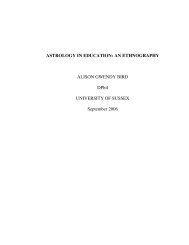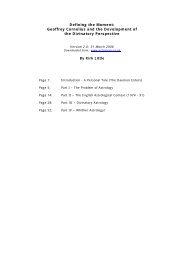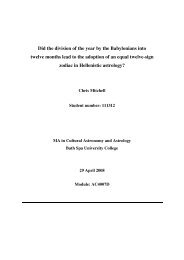Three Histories of Uranus - Astrology in the Year Zero
Three Histories of Uranus - Astrology in the Year Zero
Three Histories of Uranus - Astrology in the Year Zero
Create successful ePaper yourself
Turn your PDF publications into a flip-book with our unique Google optimized e-Paper software.
<strong>Three</strong> <strong>Histories</strong> <strong>of</strong> <strong>Uranus</strong> Page 14<br />
quite compatible. Certa<strong>in</strong>ly astrologers treat <strong>the</strong> planets as be<strong>in</strong>g able to<br />
show some sort <strong>of</strong> order <strong>in</strong> <strong>the</strong> world from a basic (implicate) pattern.<br />
Sheldrake 25 suggests that a natural extension <strong>of</strong> <strong>the</strong> morphic field approach<br />
would be to regard entire planets as organisms with characteristic morphic<br />
fields and for an astrologer this would not be a great leap. Us<strong>in</strong>g <strong>the</strong> planet<br />
Saturn as an example – because we are <strong>in</strong> <strong>the</strong> cosmos, animals, plants and<br />
men resonate with this field. Astrologers have long associated <strong>the</strong> follow<strong>in</strong>g<br />
pr<strong>in</strong>ciples with Saturn (to name a few): structure, <strong>the</strong> material world,<br />
concrete th<strong>in</strong>gs, clarity, authority, tradition, form, wisdom, ancient th<strong>in</strong>gs.<br />
This has strong similarities to what might be <strong>in</strong> <strong>the</strong> ‘science’ morphic field<br />
beg<strong>in</strong>n<strong>in</strong>g with Newton. Scientists resonate well to what might be a Saturn<br />
morphic field.<br />
In fact Gauquel<strong>in</strong> found a connection between Saturn and scientists. This<br />
would mean that as science develops, scientists’ ideas affect <strong>the</strong> Saturn field.<br />
For many astrologers this would be a new idea as I believe that most<br />
astrologers see Saturn as a fixed pr<strong>in</strong>ciple but this would need fur<strong>the</strong>r<br />
<strong>in</strong>vestigation. As this is an archetype, to use Jung’s term<strong>in</strong>ology, if one has<br />
one part <strong>of</strong> <strong>the</strong> archetype <strong>the</strong>n one automatically has <strong>the</strong> o<strong>the</strong>rs, so this<br />
could mean that scientists, due to be<strong>in</strong>g part <strong>of</strong> this field have also earned<br />
respect and authority <strong>in</strong> <strong>the</strong> world as a k<strong>in</strong>d <strong>of</strong> by-product <strong>of</strong> go<strong>in</strong>g along with<br />
<strong>the</strong> ‘concrete’ way <strong>of</strong> th<strong>in</strong>k<strong>in</strong>g and act<strong>in</strong>g. It would be <strong>in</strong>terest<strong>in</strong>g to study<br />
how views <strong>of</strong> Saturn have changed over <strong>the</strong> years among astrologers to<br />
study if <strong>the</strong>re is a l<strong>in</strong>k with <strong>the</strong> image <strong>of</strong> scientists but this is outside <strong>the</strong><br />
scope <strong>of</strong> this paper. This paper will apply this <strong>the</strong>ory to <strong>the</strong> beliefs generated<br />
about <strong>Uranus</strong> for <strong>the</strong> three groups. My hypo<strong>the</strong>sis is that <strong>the</strong> ‘<strong>Uranus</strong>’<br />
morphic field has become associated with (amongst o<strong>the</strong>rs) astrologers due<br />
to <strong>in</strong>put <strong>in</strong>to <strong>the</strong> field and <strong>the</strong> gradual stabilis<strong>in</strong>g <strong>of</strong> that field after 1781. Man<br />
as a whole has helped create what <strong>Uranus</strong> means even if <strong>Uranus</strong> is not “just<br />
a rock and has a nature <strong>of</strong> its own”.<br />
Strands <strong>of</strong> History<br />
For <strong>the</strong> Average Man<br />
Based on our experience <strong>of</strong> news today, one might expect that <strong>the</strong> discovery<br />
<strong>of</strong> a planet would have been big news to <strong>the</strong> average man as what this<br />
discovery <strong>in</strong> fact did was double <strong>the</strong> size <strong>of</strong> <strong>the</strong> known universe 26 . In fact <strong>in</strong><br />
<strong>the</strong> ‘Amsterdam Courant’ newspapers from March 1781 onwards, <strong>the</strong>re is no<br />
mention <strong>of</strong> ‘Georgium Sidus’, <strong>the</strong> name <strong>Uranus</strong> was first given by Herschel,<br />
or <strong>in</strong> fact anyth<strong>in</strong>g scientific. The newspapers, which came out twice a week<br />
and for important th<strong>in</strong>gs like <strong>the</strong> form<strong>in</strong>g <strong>of</strong> <strong>the</strong> USA sometimes on a Sunday,<br />
were divided <strong>in</strong>to countries, deaths and debts and house sales. Almost all <strong>the</strong><br />
25 Sheldrake, The Presence <strong>of</strong> <strong>the</strong> Past, pp.300-301.<br />
26 Quote from Peter H<strong>in</strong>gley <strong>of</strong> <strong>the</strong> Royal Astronomical Society.





